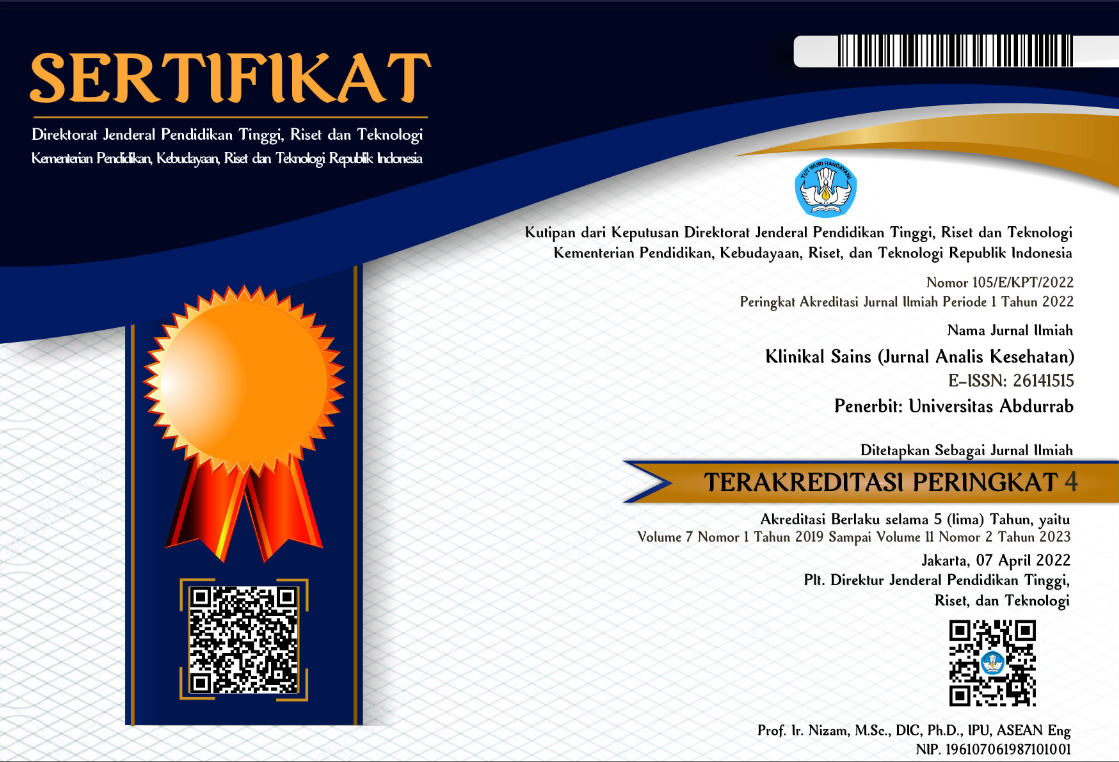REVIEW : PATOGENESIS DAN DIAGNOSA LABORATORIUM DEMAM TIFOID
Abstract
Typhoid fever caused by the pathogen bacteria named Salmonella typhi is known to have caused the death of more than 600,000 people worldwide. Understanding the pathogenesis and proper laboratory examination is very influential on the success of therapy. This literature review aims to collect literature related to pathogenesis and laboratory examination in typhoid fever. This literature review method uses the Systematic Literature Review (SLR) model based on pathogenesis and laboratory examinations. S. typhi infection begins with the entry of bacteria through the gastrointestine tract and can last up to 3 weeks. Laboratory tests for typhoid fever are bacterial culture, serological examination, molecular examination, and other investigations. Bacterial culture is a gold standard that has a sensitivity of up to 80% in blood. Serological tests can be performed such as Widal, ELISA, SDS-PAGE blotting, RDT or POCT tests using venous blood, capillary blood, even serum, and typhidot, and Tubex TF. Other investigations can be characterized by leukocytosis and eosinopenia. Blood chemistry tests also found an increase of AST and ALT 2-3 times the normal value.
References
Baker, S., Favorov, M. & Dougan, G., 2010. Searching for the elusive typhoid diagnostic. BMC Infect Dis, I(10).
Chart, H. et al., 2007. Serodiagnosis of salmonella enterica serovar typhi and serovar paratyphi A,B and C human infections. J Med Microbiol, Issue 56, pp. 1161 -1166.
Crump, J., Sjolund-KArlsson, M., Gordon, M. & Parry, C., 2015. Epidemiology, clinical presentation, laboratory diagnosis, antimicrobial resistence, and antimicrobial management of invasive Salmonella infections. Clin Microbiol Rev, 28(5).
Gordon, M. et al., 2010. Invasive non-typhoidal salmonellae establish systemic intraceluler infection in HIV ifected adults an emerging disease pathogenesis. Clin Infect Dis, Issue 50, pp. 953-962.
House, D. et al., 2001. Typhoid fever: pathogenesis and disease. Curr Opin Infect, Issue 14, pp. 573 - 578.
Kaur, J. & Jain, S., 2012. Role of antigens and virulence factors od salmonella enterica serovar typhi in its pathogenesis. Microbiological research, 1(1), pp. 199-210.
Kumar, A. et al., 2010. Quick PCR based diagnosis of typhoid using spesific genetic markers. Biotechnol Lett, Issue 53, pp. 707 - 712.
Kumar, G. et al., 2012. Use of urine with nested PCR targeting the flagellin gene (fliC) for diagnosis of typhoid fever. J Clin Microbiol , Issue 50, pp. 1964 - 1967.
Ley, B. et al., 2010. Evaluation of widal tube aglutination test for the diagnosis of typhoid fever among children admitted to a rural hospital in Tanzania and a comparison with previous studies. BMC Infect Dis, Issue 10, p. 180.
Lozano, R. et al., 2010. Global and regional mortality frm 235 causes of death for 20 age groups in 1990 and 2010 : asystematic analysis for The Globa Burden of Disease study. Lancet, Issue 380, pp. 2095 - 1228.
Mogasale, V. et al., 2014. Burden of typhoid fever in low income and middle come countries: a systematic, literature-based update with risk factor adjusment. Lancet Glob Health, Issue 2, pp. 570 - 580.
Moore, C. et al., 2014. Evaluation of the diagnostic accuracy of a typhoid IgM flow assay for the diagnostic of typhoid fever in Cambodian children using a Bayesian latent class model assuming an imperfect gold standard. Am J trop Med Hyg, Issue 90, pp. 114 - 120.
Muchtarommah, B., 2014. pengauh Dosis dan lama pemberian tepung cacing tanah terhadap kadar enzim SGPT dan SGOT tikus yang terinfeksi Salmonella typhi. National Conference Green Technology, Issue 3, pp. 345 - 350.
Nelwan, R., 2012. Tata Laksana Terkini Demam Tifoid. Continuin Medical Education : CDK, 39(4).
Nga, T. et al., 2010. The sensitivity of real time PCR amplification targeting invasive Salmonella serovars in biological specimens. BMC Infect Dis, Issue 10, p. 125.
Parry, C. et al., 2002. Typhoid Fever. N Engl J Med, Issue 347, pp. 1770 - 1782.
Pulickal, A. et al., 2009. Kinetics of the natural, humoral immune response to Salmonella enterica serovar typhi in Kathmandu,Nepal. Clin Vaccine Immunol, Issue 16, pp. 1413-1419.
Siba, V. et al., 2012. Evaluation of serological diagnostic test for typhoid fever in Papua New Guinea using composite reference standard. Clin Vaccine Immunol, Issue 19, pp. 1833 - 1837.
Sidabutar, S. & Satari, H., 2010. Pilihan Terapi empiris Demam Tifoid pada Anak: Kloramfenikol atau Seftriakson?. Sari Pediatri, Issue 11, pp. 434-439.
Singh, S., 2001. Symposium: Typhoid fever pathogenesis and laboratory diagnosis. J Indian Academy of Clinical Medicine, II(1).
Tam, F. et al., 2008. New rapid test dor paratyphoid a fever : usefulness, cross-detection, and solutin. Diagn Microbiol Infect Dis, Issue 62, pp. 142 - 150.
Tarupiwa, A. et al., 2015. Evaluation of Tubex TF and Onsite Typhoid IgG/IgM Combo rapid test to detect Salmonella enterica serovar typhi infection during a typhoid outbreaks in Harare, Zimbabwe. BMC Res Notes, Issue 8, p. 50.
Tortora, G., Berdell, R. & Case, C., 2013. Microbiology: an Introduction. 11th ed. s.l.:Pearson.
Waddington, C. et al., 2014. An outpatient, ambulant-design, controlled human infection model using escalating doses of Salmonella Typhi challenge delivered in sodium bicarbonate solution. Clin Infect Dis, Issue 347, pp. 1770 - 1782.
Copyright (c) 2020 Klinikal Sains : Jurnal Analis Kesehatan

This work is licensed under a Creative Commons Attribution-NonCommercial-ShareAlike 4.0 International License.
1. Copyright of all journal manuscripts is held by the Klinikal Sains : Jurnal Analis Kesehatan
2. Formal legal provisions to access digital articles of electronic journal are subject to the provision of the Creative Commons Attribution-ShareAlike license (CC BY-NC-SA), which means that Klinikal Sains : Jurnal Analis Kesehatan is rightful to keep, transfer media/format, manage in the form of databases, maintain, and publish articles.
3. Published manuscripts both printed and electronic are open access for educational, research, and library purposes. Additionally, the editorial board is not responsible for any violations of copyright law.
licensed under a Creative Commons Attribution-ShareAlike 4.0 International License.
 pdf
pdf
 Abstract views: 3806
Abstract views: 3806
 downloads: 3574
downloads: 3574

 :
:






